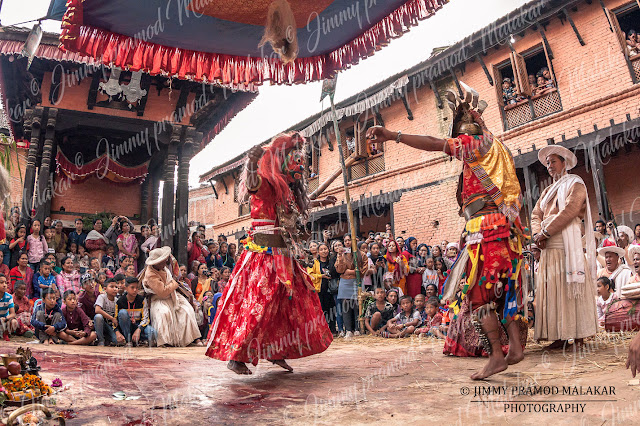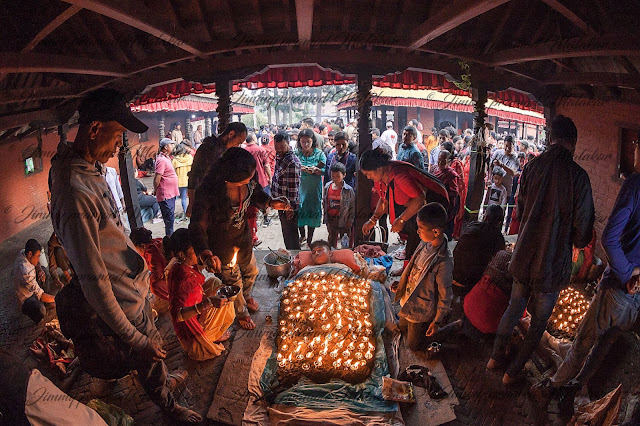People
from ethnic Newar community participate in celebration of New Year
Nepapl Sambat 1140 in Kathmandu,Nepal. Nepal Sambat, found by
Shankhadhar Sakhwa, is a national lunar calendar of Nepal which begins
on fourth day of Tihar festival.Nepal’s Newar community marks the
commencement of the Nepal Sambat ‘1140’, today. The Nepal Sambat is the
new year of the Newar community.
On the occasion, Prime Minister KP Sharma Oli extended his greetings to the Newari community and all Nepalis stating that the Nepal Sambat would encourage all Nepalis to be united. Nepal Sambat 1140 Kachhala Tho Paru (Tuesday) is an unequal day – much different from any other ordinary day in any measurable aspect. The golden rays of the rising sun stroking the pinnacles of the majestic Himalayas on this day heralds in a brand New Year in Nepal and aspires all Nepalis, wherever they be, to recollect, rejoice and reconcile for an altogether new beginning.
It was then 1139 years ago that an ordinary lay citizen, neither a king nor a saint, by the name of Sankhadhar Sakhwa, who came into a large fortune by way of gold in the sand, with a pure Nepali heart pounding in his chest, redeemed all his countrymen of all their debts and dues so that they all could wipe their tears and look up front to an altogether new life and a new beginning.
Relieved, reborn, Nepal marked the day as a new beginning in time, the beginning of a new era and with hardened patriotism and grace of the land, named it Nepal Sambat to continue timeless into the future. Nepal Sambat is the chronicle of Nepal and the Nepalis. Tuesday is that day, 1140 years into the present. On this day, a deep blue sky, a cool fresh breeze and flowers in myriad colours and shapes congregate into a wholesome harmony in Nepal. It is a day when spontaneity springs forth from all quarters. On this day, peace and harmony reverberate in the air – in all animate and in all inanimate.
On all other days, the physical pays homage to the spiritual, but this day is special, as on the first day of Nepal Sambat, the spiritual pays homage to the physical. It is the day when the Newars perform the special ritual known as ‘Mha Puja’ (literally, body worship), a homage to the physical embodiment of the self that it may endure in good health and carry the spirit to the next new year.
And it is the day when all Nepalis exchange greetings with all of their kind and all of their friends with a spontaneous flow of good wishes and goodwill echoed in one single word “Bhintuna” (Wish you good!).
And that is what Nepal needs now – the spirit and the physical endowments to look and stride up front towards a new beginning, the spirit of goodwill and good wishes, the spirit of brotherhood, sisterhood, nationhood and a bonded unity among all Nepalis regardless of their ethnic origins – all soaked in a spirit of peace and harmony. Nepal Sambat carries an unfailing message to every Nepali: look within yourself and see Sankhadhar Sakhwa smile in your heart. Bhintuna.
On the occasion, Prime Minister KP Sharma Oli extended his greetings to the Newari community and all Nepalis stating that the Nepal Sambat would encourage all Nepalis to be united. Nepal Sambat 1140 Kachhala Tho Paru (Tuesday) is an unequal day – much different from any other ordinary day in any measurable aspect. The golden rays of the rising sun stroking the pinnacles of the majestic Himalayas on this day heralds in a brand New Year in Nepal and aspires all Nepalis, wherever they be, to recollect, rejoice and reconcile for an altogether new beginning.
It was then 1139 years ago that an ordinary lay citizen, neither a king nor a saint, by the name of Sankhadhar Sakhwa, who came into a large fortune by way of gold in the sand, with a pure Nepali heart pounding in his chest, redeemed all his countrymen of all their debts and dues so that they all could wipe their tears and look up front to an altogether new life and a new beginning.
Relieved, reborn, Nepal marked the day as a new beginning in time, the beginning of a new era and with hardened patriotism and grace of the land, named it Nepal Sambat to continue timeless into the future. Nepal Sambat is the chronicle of Nepal and the Nepalis. Tuesday is that day, 1140 years into the present. On this day, a deep blue sky, a cool fresh breeze and flowers in myriad colours and shapes congregate into a wholesome harmony in Nepal. It is a day when spontaneity springs forth from all quarters. On this day, peace and harmony reverberate in the air – in all animate and in all inanimate.
On all other days, the physical pays homage to the spiritual, but this day is special, as on the first day of Nepal Sambat, the spiritual pays homage to the physical. It is the day when the Newars perform the special ritual known as ‘Mha Puja’ (literally, body worship), a homage to the physical embodiment of the self that it may endure in good health and carry the spirit to the next new year.
And it is the day when all Nepalis exchange greetings with all of their kind and all of their friends with a spontaneous flow of good wishes and goodwill echoed in one single word “Bhintuna” (Wish you good!).
And that is what Nepal needs now – the spirit and the physical endowments to look and stride up front towards a new beginning, the spirit of goodwill and good wishes, the spirit of brotherhood, sisterhood, nationhood and a bonded unity among all Nepalis regardless of their ethnic origins – all soaked in a spirit of peace and harmony. Nepal Sambat carries an unfailing message to every Nepali: look within yourself and see Sankhadhar Sakhwa smile in your heart. Bhintuna.




















































